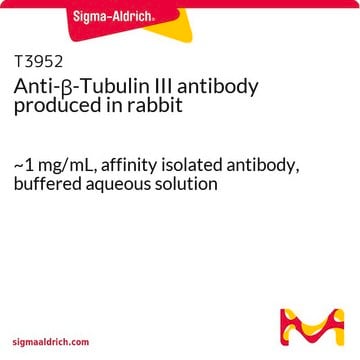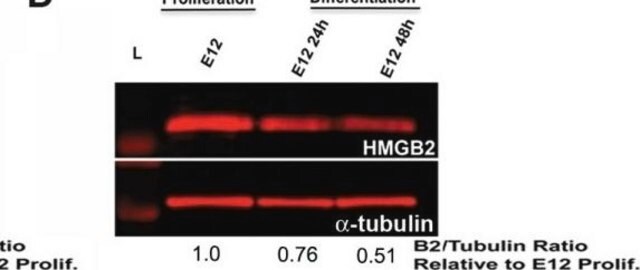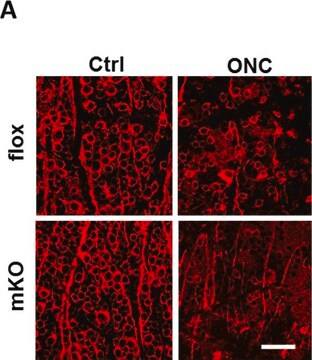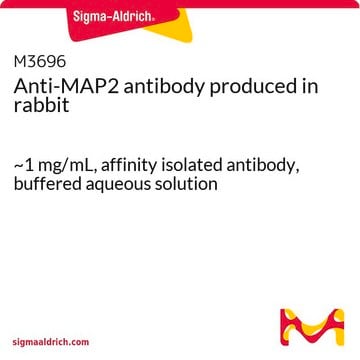Consistent results on mouse and human tissue (nerves of the pancreas) as well as primary culture of sensory neurons. usual usage on tissue and cells: 1:500 (in blocking solution: 7 to 10% Horse serum in PBS)
T2200
Anti-β-Tubulin III Antibody

rabbit polyclonal
Sinonimo/i:
Anti-Tuj 1
Scegli un formato
Scegli un formato
About This Item
Prodotti consigliati
Nome del prodotto
Anti-β-Tubulin III antibody produced in rabbit, affinity isolated antibody, buffered aqueous solution
Origine biologica
rabbit
Coniugato
unconjugated
Forma dell’anticorpo
affinity isolated antibody
Tipo di anticorpo
primary antibodies
Clone
polyclonal
Stato
buffered aqueous solution
PM
antigen ~55 kDa
Reattività contro le specie
rat, human, mouse
Convalida avanzata
knockout
Learn more about Antibody Enhanced Validation
tecniche
immunoprecipitation (IP): 10 μg using RIPA extract (250 μg) of cultured rat PC12 cells
indirect immunofluorescence: 10-20 μg/mL using rat PC12 cells
western blot: 0.2-0.4 μg/mL using whole extracts of mouse brain or cultured human neuroblastoma SH-SY5Y cells
N° accesso UniProt
Condizioni di spedizione
dry ice
Temperatura di conservazione
−20°C
modifica post-traduzionali bersaglio
unmodified
Informazioni sul gene
human ... TUBB3(10381)
mouse ... Tubb3(22152)
rat ... Tubb3(246118)
Cerchi prodotti simili? Visita Guida al confronto tra prodotti
Categorie correlate
Descrizione generale
α/β-Tubulin, an integral component of microtubules, is present in almost all eukaryotic cells.
α/β-Tubulin occurs mostly as soluble (approx. 100-110 kDa) heterodimeric sets of α- and β-tubulin isotypes or as polymers in assembled microtubules. β-Tubulin III (also designated β-4 chain) is found in the brain and dorsal root ganglia and appears to be localized to neurons of the central and peripheral nervous system. β-tubulin III is also found in Sertoli cells of the testis, spermatozoa tails, certain lung cells, and apparently some breast stromal cells.
Specificità
Immunogeno
Applicazioni
- Immunofluorescence
- Immunostaining
- Western blotting
- immunofluorescence
- immunostaining
- western blotting
- indirect immunoperoxidase assay (IPA)
Azioni biochim/fisiol
Stato fisico
Nota sulla preparazione
For extended storage, freeze in working aliquots. Repeated freezing and thawing is not recommended. Storage in frost-free freezers is also not recommended. If slight turbidity occurs upon prolonged storage, clarify the solution by centrifugation before use. Working dilutions should be discarded if not used within 12 hours.
Altre note
Esclusione di responsabilità
Non trovi il prodotto giusto?
Prova il nostro Motore di ricerca dei prodotti.
Prodotti correlati
Codice della classe di stoccaggio
12 - Non Combustible Liquids
Classe di pericolosità dell'acqua (WGK)
WGK 1
Punto d’infiammabilità (°F)
Not applicable
Punto d’infiammabilità (°C)
Not applicable
Scegli una delle versioni più recenti:
Certificati d'analisi (COA)
Non trovi la versione di tuo interesse?
Se hai bisogno di una versione specifica, puoi cercare il certificato tramite il numero di lotto.
Possiedi già questo prodotto?
I documenti relativi ai prodotti acquistati recentemente sono disponibili nell’Archivio dei documenti.
I clienti hanno visto anche
Protocolli
Cultivate ReNcell® human neural stem cells in 3D hydrogels for high-throughput screening using the TrueGel3D® HTS Hydrogel Plate with this protocol.
Filtri attivi
Il team dei nostri ricercatori vanta grande esperienza in tutte le aree della ricerca quali Life Science, scienza dei materiali, sintesi chimica, cromatografia, discipline analitiche, ecc..
Contatta l'Assistenza Tecnica.

















